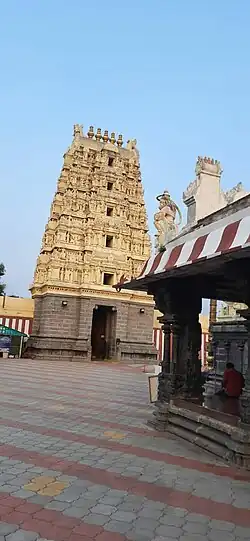Ayothiapattinam
Ayothiapattinam is a panchayat town located in Vazhapadi taluk of Salem district in the state of Tamil Nadu, India. This village is called Ayothyapatinam because of its Rama temple. The temple is thought to remain from the time of Ramayana.
Ayothiapattinam
அய்யோதியபட்டினம் | |
|---|---|
 Ayothiyapattinam Rama temple | |
| Coordinates: 11°39′29″N 78°14′37″E | |
| Country | |
| State | Tamil Nadu |
| Taluk | Vazhapadi |
| District | Salem |
| Elevation | 328 m (1,076 ft) |
| Population (2001) | |
| • Total | 9,956 |
| Languages | |
| • Official | Tamil |
| Time zone | UTC+5:30 (IST) |
Geography
Location
Ayothiapattinam is located 7 km east of Salem city. It acts as a gateway to Salem City for the people coming from east and northeast districts of Tamil Nadu. It is located 35 km from Yercaud, 168 km from Coimbatore, 195 km from Bengaluru and 330 km from Chennai.
Demographics
At the 2001 India census,[1] Ayothiapattinam had a population of 9,956. Males constituted 50% of the population and females 50%. Ayothiapattinam had an average literacy rate of 67%, higher than the national average of 59.5%; with 56% of the males and 44% of females literate. 11% of the population was under 6 years of age.
KodandaRamaswamy temple
KodandaRamaswamy temple is a Temple of Lord Rama built by Maharishi Bharadvaja . This temple's sanctorum is said to be built by Bhardvaja himself and later constructed by Adhiyaman king. There is a RajaGoupura built by Tirumala Nayaka.[2]


As per Legend, Rama, Sita, Lakshmana and Hanuman while returning from Sri Lanka Stayed in the Bharadvaja Maharishi Ashrama Which was located here. The great Rishi Bharadvaja wanted to see the divine pattabisheka of Rama. Rama wanted to full-fill the wishes of Maharishi and he gave a darshan to the maharishi and Bharadvaja maharishi prathishtaied the Archa roopam of Sri Rama.[2]
The sanctum sanctorum was built by king Adhiyaman and the other mandapas with great Architechture built by Tirumala Nayaka. This temple is one of the Purana kshethram and Abhimana sthalam as it is mentioned in Ramayana and highly worshiped Vishnu temple.
References
- "Census of India 2001: Data from the 2001 Census, including cities, villages and towns (Provisional)". Census Commission of India. Archived from the original on 16 June 2004. Retrieved 1 November 2008.
- "Travel Articles | Travel Blogs | Travel News & Information | Travel Guide | India.comSri Kodandapani Ramar temple in Tamil Nadu: 7 interesting facts you should know this Ram Navami | India.com". www.india.com.
